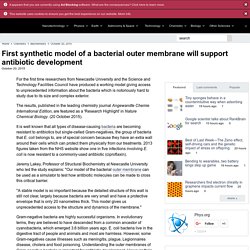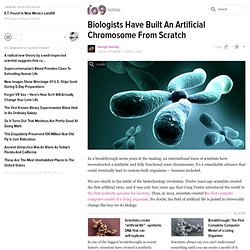

An Accurate In Vitro Model of the E. coli Envelope - Clifton - 2015 - Angewandte Chemie International Edition. Communication You have full text access to this OnlineOpen article Dr.

Luke A. Clifton2, Dr. Stephen A. Article first published online: 1 SEP 2015 DOI: 10.1002/anie.201504287 © 2015 The Authors. Issue. First synthetic model of a bacterial outer membrane will support antibiotic development. For the first time researchers from Newcastle University and the Science and Technology Facilities Council have produced a working model giving access to unprecedented information about the bacteria which is notoriously hard to study due to its size and complex exterior.

The results, published in the leading chemistry journal Angewandte Chemie International Edition, are featured as a 'Research Highlight' in Nature Chemical Biology. (20 October 2015). It is well known that all types of disease-causing bacteria are becoming resistant to antibiotics but single-celled Gram-negatives, the group of bacteria that E. coli belongs to, are of special concern because they have an extra wall around their cells which can protect them physically from our treatments. 2013 figures taken from the NHS website show one in five infections involving E. coli is now resistant to a commonly-used antibiotic (ciproflaxin).
Gram-negative bacteria are highly successful organisms. More information: Luke A. DARPA: We Are Engineering the Organisms That Will Terraform Mars. Terraformed Mars, artist's conception.

Image: Daein Ballard/Wikimedia Commons It’s no secret that the Defense Advanced Research Projects Agency is investing heavily in genetic engineering and synthetic biology. Whether that excites or terrifies you depends on how you feel about the military engineering totally new life forms. If you’re in the excitement camp, however, here’s a nugget for you: DARPA believes that it's on the way to creating organisms capable of terraforming Mars into a planet that looks more like Earth. The goal of terraforming Mars would be to warm up and potentially thicken its atmosphere by growing green, photosynthesizing plants, bacteria, and algae on the barren Martian surface. “For the first time, we have the technological toolkit to transform not just hostile places here on Earth, but to go into space not just to visit, but to stay,” Alicia Jackson, deputy director of DARPA’s new Biological Technologies Office said Monday at a DARPA-hosted biotech conference.
Development of an artificial cell, from self-organization to computation and self-reproduction. Author Affiliations Contributed by Albert Libchaber, November 22, 2010 (sent for review October 13, 2010) Abstract This article describes the state and the development of an artificial cell project.

We discuss the experimental constraints to synthesize the most elementary cell-sized compartment that can self-reproduce using synthetic genetic information. The original idea was to program a phospholipid vesicle with DNA. Footnotes. Grand Challenges in Synthetic Biology to be Accomplished. When engineering science meets biological science, synthetic biology is created.

Over the past half century, systems engineering has seen numerous successful applications in the engineering field such as manufacturing, electronics, telecommunications, computer, and networks, etc. At the same time, biological systems have been dealt in a reductionist way which resulted in accumulation of numerous but relatively fragmented biological information on genes and proteins, and their interactions. With the advent of genomics and other high-throughput technologies, biological paradigm has been shifted to a holistic view on a living system as a whole for understanding of complex life phenomena and living systems and for modification of genes, proteins, metabolites, and other cellular components in order to obtain novel functions/products. 1.
Modeling for Synthetic Biology Practice 2. 3. 4. 5. 6. Conclusion References. Biologists Have Built An Artificial Chromosome From Scratch. The new chromosome, called SynIII, involved the design and creation of 273,871 base pairs of DNA — fewer than the 316,667 pairs in the original chromosome.

That's over 50,000 modifications! Nit pick: Over 50,000 fewer base pairs does not mean 50,000 modifications, they're considering each base pair on a case-by-case basis, they look at what each segment is (a gene that codes for a certain protein, etc) and then remove it as a segment, that sounds more like maybe 100 modifications, each on average about 500 base pairs being removed. I am curious if this means we've got the basic means to construct something like Smallpox from scratch. :O Considering it is designed to take over the cell it is in and make copies (admittedly with the help of proteins) it seems like a reasonable concern. Synthetic Biology Explained.